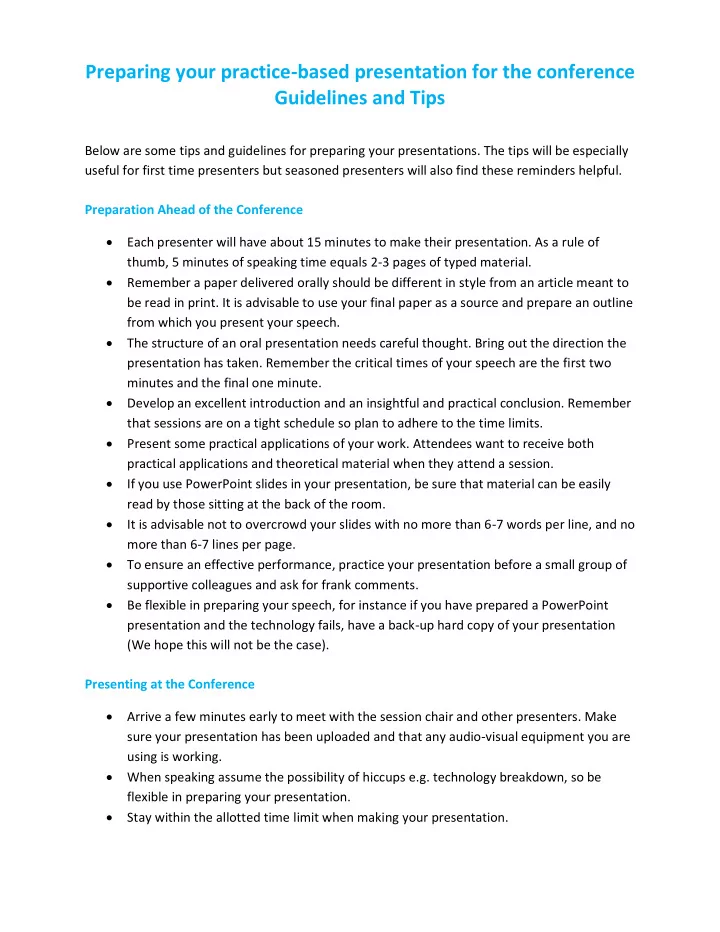

Preparing your practice-based presentation for the conference Guidelines and Tips Below are some tips and guidelines for preparing your presentations. The tips will be especially useful for first time presenters but seasoned presenters will also find these reminders helpful. Preparation Ahead of the Conference Each presenter will have about 15 minutes to make their presentation. As a rule of thumb, 5 minutes of speaking time equals 2-3 pages of typed material. Remember a paper delivered orally should be different in style from an article meant to be read in print. It is advisable to use your final paper as a source and prepare an outline from which you present your speech. The structure of an oral presentation needs careful thought. Bring out the direction the presentation has taken. Remember the critical times of your speech are the first two minutes and the final one minute. Develop an excellent introduction and an insightful and practical conclusion. Remember that sessions are on a tight schedule so plan to adhere to the time limits. Present some practical applications of your work. Attendees want to receive both practical applications and theoretical material when they attend a session. If you use PowerPoint slides in your presentation, be sure that material can be easily read by those sitting at the back of the room. It is advisable not to overcrowd your slides with no more than 6-7 words per line, and no more than 6-7 lines per page. To ensure an effective performance, practice your presentation before a small group of supportive colleagues and ask for frank comments. Be flexible in preparing your speech, for instance if you have prepared a PowerPoint presentation and the technology fails, have a back-up hard copy of your presentation (We hope this will not be the case). Presenting at the Conference Arrive a few minutes early to meet with the session chair and other presenters. Make sure your presentation has been uploaded and that any audio-visual equipment you are using is working. When speaking assume the possibility of hiccups e.g. technology breakdown, so be flexible in preparing your presentation. Stay within the allotted time limit when making your presentation.
Stop on time. Remember there are other speakers during this time slot, so be considerate of their time. As you speak, establish eye contact with the audience; vary your styles of presentation. Don't read handouts verbatim when talking. Simply refer to them, but allow participants to be actually involved in developing the outcome. Be enthusiastic as you present as your presentation will leave a first impression of your work. If it is positive, then their overall impression of you and your work is reinforced. Enjoy yourself as you present your paper! Tip for Preparing Your Power Point Presentation 1. Use PowerPoint to prepare your presentation, other software formats (e.g. Prezi may be used as well). 2. Each presenter has about 15 minutes, so consider using 15 slides or less 3. The first slide should include: Presentation title, author names, institution etc 4. The middle slides should try to cover the following elements of your study or work: i. Introduction This should provide the context and justification for the practice and address the following issues: o what is the problem/opportunity being addressed? o which target audience/population is being affected? o how is the problem impacting on the target audience/population? o what were the objectives being achieved? ii. Design (Plan) & Implementation of the Practice What is the design, plan or strategy of the practice o what are the main activities carried out? o when and where were the activities carried out? o who were the key implementers and collaborators? o what were the resource implications? iii. Results of the Practice – Outputs and Outcomes what were the concrete results achieved in terms of outputs and outcomes? was an assessment of the practice carried out? If yes, what were the results? iv. Lessons Learnt what worked really well – what facilitated this? RESEARCH & DEVELOPMENT UNIT Contact: submissions@avu.org
what did not work – why did it not work? v. Conclusion how have the results benefited the target audience/population? why may that intervention be considered a “Best Practice”? recommendations for those intending to adopt the documented “Best Practice” or how it can help people working on the same issue(s). vi. Further Reading provide a list of references that give additional information on the “Best Practice” for those who may be interested in ho w the results have benefited the population. Consent By submitting an abstract and presentation to this conference, you are giving permission for your abstract & presentation to be made available on the internet and accessible to the general public. RESEARCH & DEVELOPMENT UNIT Contact: submissions@avu.org
Recommend
More recommend